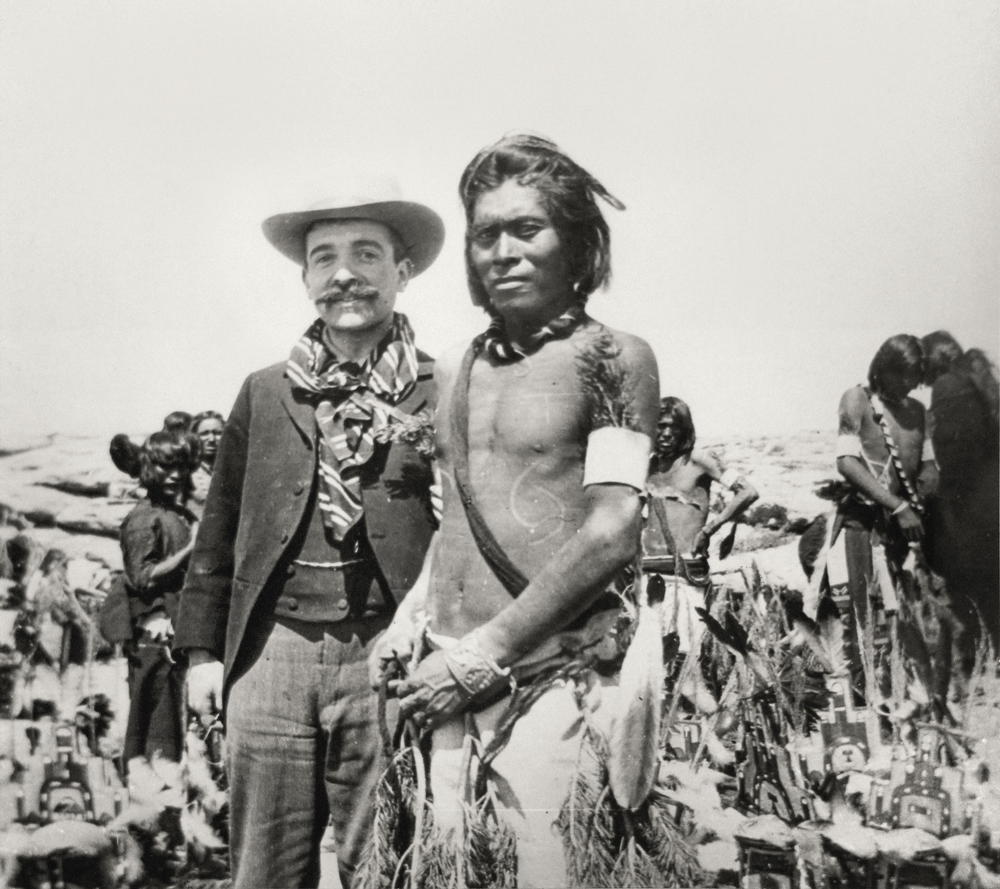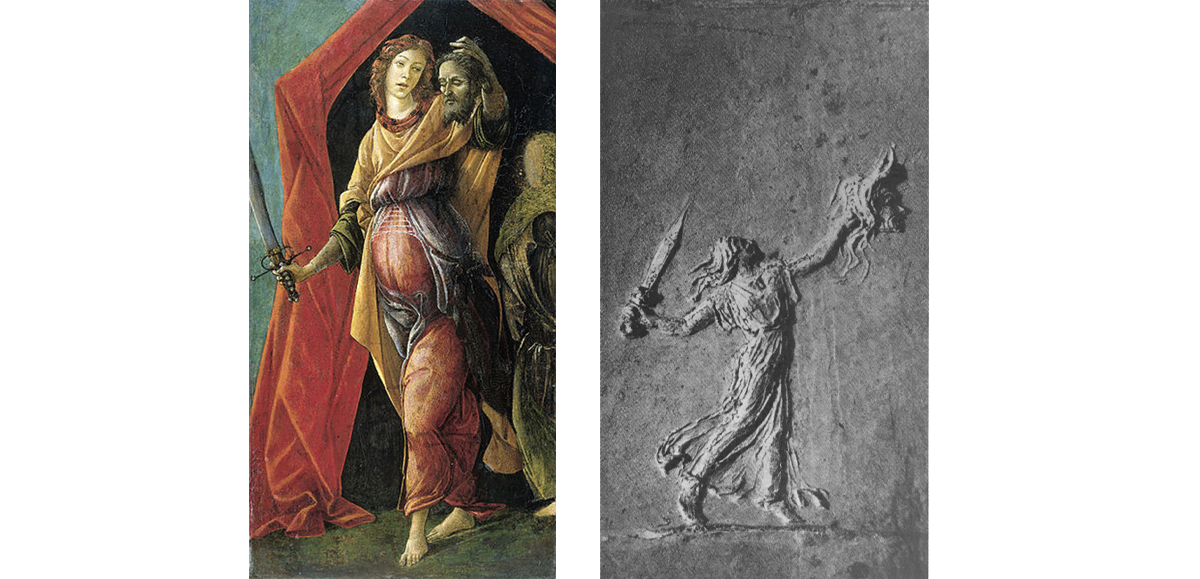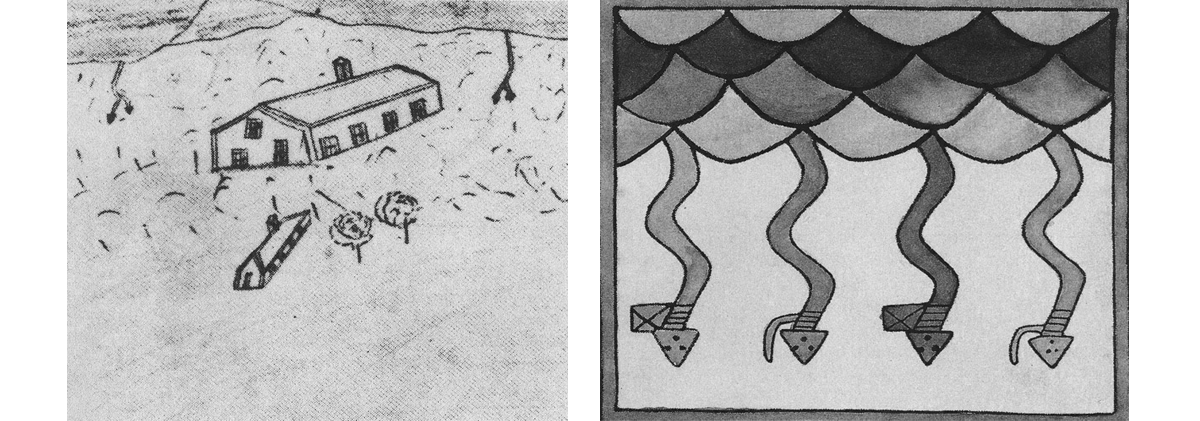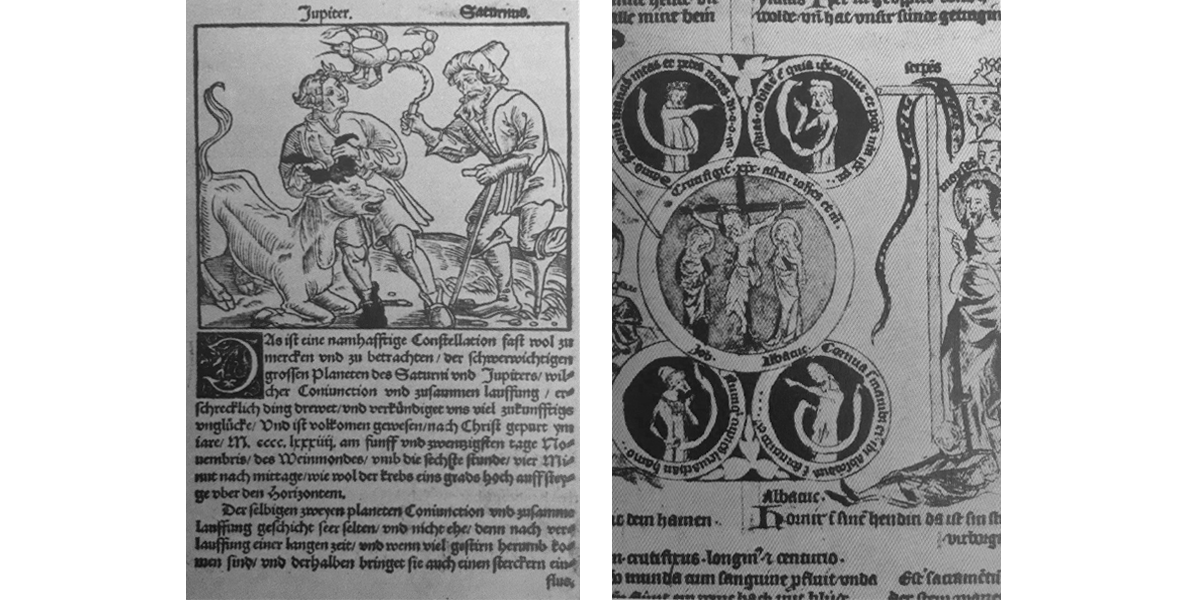
1 | Warburg with a Pueblo (from F. Saxl, Lectures, plate 231).
Aby Warburg, the founder of the Warburg Institute, was in the middle of making plans for the organisation of the Twenty-Fourth Congress of American Anthropology when he died on 26th October, 1929. He had been looking forward to this Congress with great expectations, for by inviting it to meet on the premises of his library he had intended to repay an old debt. He had felt himself under a deep obligation towards American ethnologists ever since his return in 1896 from a visit to the United States which had played a decisive part in his life (Pl. 231).
It is not immediately clear why this should be so. A casual visitor will find only a small number of books in the library and few pictures in the photographic collection which bear directly on anthropological studies. With its four main sections on history of art, of religion, natural science and philosophy, of language and literature, and on political and social history the library looks as if it were designed for the study of the history of civilisation in general. It would necessarily be incomplete for this purpose; and to the student of primitive cultures in particular it must appear as a very poor instrument. However, it serves special rather than general problems; and it aims at completeness only where these are concerned. One of them—and this is in fact our central problem—is the question of how classical antiquity affected the mediaeval and modern civilisations of the Mediterranean. It seems, therefore, that the Institute’s concern is only with Europe. Why then should it include American anthropology at all, and why should this, in the founder’s opinion, even be necessary? I believe my best way to explain this is to describe Warburg’s own development. This is not merely a biographical matter; for the growth of the library goes hand in hand with that of Warburg’s personality and ideas, and if we younger scholars hope to maintain the Institute in the spirit in which he planned it it is because he taught us that our problems ultimately concern both this old world and the new one. I said “ultimately” because first I have to take you away from the Red Indians and lead you to the European scene. For what Warburg owed to America was that he learned to look at European history with the eyes of an anthropologist.
He did not set out to study the American Indians; he began, on the contrary, with studies in the history of Florentine art. But what appealed to him in Florence was something quite different from what attracts the conventional historian of art. It was not his object to understand he individuality of an artist or the genesis of his style. He was never concerned with the attribution of pictures to this or that master, or with differences of opinion about the architectural history of Florence Cathedral. His work was largely based on the use of archives for art historical purposes, but he did not ransack the archives merely in search of new records. Even the history of Florentine art as a whole hardly ever occupied him. His interest was limited to a single relatively short period which, however, appeared to him as an epoch of vast significance in terms of the history of mankind; it was the decades of the end of the fifteenth century, the flowering of the so-called Early Renaissance, the period of Botticelli, Pollaiuolo and Ghirlandaio. That period saw the most vigorous revival of classical antiquity on European soil, but in its handling of the classics it differed completely from, let us say, the eighteenth century (Pl. 232a). In the fifteenth century—and this was Warburg’s primary observation—the term “classical” did not mean “noble simplicity and quiet grandeur” (Winckelmann [1755] 1825, 34). What the eighteenth century called the “ideal” classical manner would not have appeared to the Early. Renaissance in the same light. What then did “antiquity” mean to that period? The early years of Warburg’s life in Florence were devoted to the sifting and arranging of materials to clarify this question. I think it was not the least of his merits that he turned to American anthropology for help in solving it.

2 | Filippino Lippi, Tre Ninfe, fine XV- inizio XVI sec., Oxford, Christ Church Cathedral (da F. Saxl, Lectures, plate 232a).
3 | Cleo Jurino, Disegno cosmologico, 1896, Santa Fé (da F. Saxl, Lectures, plate 232b).
4 | Quaresima fiorentina, incisione su rame, 1475/1490, Firenze, Galleria degli Uffizi (da F. Saxl, Lectures, plate 232c).
In 1895–96 Warburg was in the United States; it was a journey to the archetypes. The Early Renaissance had found its model and in order to gain an insight into classical paganism the historian can do no better than to go to a pagan country. Warburg was the pupil not only of the art historians Justi and Janitschek but also of Usener, that is to say, of that German school of the history of religions which, like Frazer’s in England, sought to understand the classical texts and the origins of Greek and Roman religions through the medium of living paganism. As Usener’s pupil, therefore, he went to Santa Fè, to Albuquerque and to the district of the Mesa Verde. He found the authorities of the Smithsonian Institution most willing to advise and assist him, and he retained for them a life-long sense of deep gratitude. On Indian territory he was, above all, profoundly impressed by two experiences in the light of which he began to understand his European problems. He saw, on the one hand, the ritual of Indian festivals, dances which were manifestly an expression of religious emotion; on the other hand, he observed the coining and transmission of symbols.
He devoted particular attention to the snake as the symbol of lightning (Pl. 232b). Why is lightning represented as a snake and how does it come about that such a symbolic form is coined? That was his first question; the second was: how vigorously does the image “snake” survive once it has taken shape? Is it still alive, even in places where European influences prevail? Warburg began to realise that the forming of a symbol, like “snake” for lightning, must be understood as an act of enlightenment. The frightened Indian tries to make the momentary appearance of the flash intelligible to himself by comparing it to the snake which he can grasp physically. Or rather, the two things coalesce—for it is typical that in his reasoning the “like”, which keeps the two parts of a comparison distinct, is omitted: for him, lightning “is” snake. It has the same flickering shape as the snake when it rushes away; it is his mortal enemy just as the snake is. By equating the two it becomes possible for him to grasp the intangible. In other words, a symbol serves to circumscribe a shapeless terror. It springs from sensations of awe and danger and becomes man’s defence against the unknown. For the lightning cannot be controlled, but the snake, though it is terrifying, can be mastered. It can be made part of man’s own body—the Walpi snake dancers, as you know, hold the snakes in their mouths while dancing—it can be sent down into the earth as a messenger to procure rain.

5 | Sandro Botticelli, Giuditta con la testa di Oloferne, 1497, Amsterdam, Rijsmuseum (da F. Saxl, Lectures, plate 233a).
6 | Menade frenetica, rilievo in stucco, I secolo d.C., Roma, Basilica sotteranea di Porta Maggiore (da F. Saxl, Lectures, plate 233b).
Warburg made an experiment to test the power which resides in such a symbol even today. He asked an English-speaking teacher in Keam’s Cañon to tell his Indian schoolchildren a story in which a thunderstorm occurs, the story of Johnny-head-in-the-air. The children were to illustrate this story and the question was whether it would occur to any of those Americanized Indian children to represent the lightning in the symbol of the snake. The lively drawings which they made are now the property of the Hamburg Museum of Ethnology. As was only natural, most of the children represented lightning in its schematized shape; but two out of fourteen still drew the indestructible symbol of the arrow-headed snake as their forebears used to represent it in their sand-paintings in the underground sanctuary of the Kiwa. (Pl. 234a, 234b).
Through Jacob Burckhardt, whose Civilization of the Renaissance in Italy Warburg had loved, admired and re-read many times since his student days, he had become familiar with the paganizing festivals of the Florentine Renaissance. After his return from America Warburg saw them with different eyes. The mascarades with their carri, Lorenzo de’ Medici’s Canti Carnascialeschi appeared to him as the progeny of those dances which he had seen at the Mesa Verde. He realised that the meaning of these pagan games of the Renaissance is their ultimately religious key-note. He began to see why for the Early Renaissance classical antiquity meant a keener sense of movement, why life on the classical pattern expressed itself in the elated atmosphere of festive display; for the surviving traces of the ancient world contain the remnants of the strongest emotional experiences of primitive mankind. The orgiastic ceremonies of the Zuni lie hidden behind the Canti Carnascialeschi (PI. 232c). The re-awakening of antiquity in the early Renaissance which was signalized by a heightening of gestures in life and art meant a renewal of those highly-charged forms of expression which have their origin in some of the most profound emotions and desires of mankind.
It is partly due to Warburg’s experiences in Indian territory where he had begun to understand the meaning of the snake symbol and its power to survive that he became the historian of those symbolic images which the ancient world had created and which survive in modern Europe. One of the most typical figures of the Early Renaissance is that of “Judith with the head of Holofernes, the head-huntress” as Warburg called her (Pl. 233a). He found the pagan model for it in the frenzied maenad of Dionysus (Pl. 233b). Here it becomes almost uncannily clear how closely related the American phenomena are to the European ones; and you see how Warburg’s interpretation of art arose from his experience among the Indians. Symbolic forms are coined in the depths of human experiences: the snake is the symbol of lightning, the head-bearer that of the frenzied woman in her triumph over the male. These symbols have the power to limit and condense fear and awe; and because they rise from the depth and at the same time make it articulate, they survive in that strange medium which Warburg and others have called the social memory (Hering [1870] 1921, Semon 1908, Butler 1877 and 1880; see also Lee 1923 and Hartog 1924). The lightning-snake still lives on in the minds of Americanized Indian children; the maenad appears in Early Renaissance Florence as a christianized figure, a formula for intense emotion reinstated from classical antiquity.

7 | Fulmine sotto forma di serpente, disegno di uno studente nativo (da F. Saxl, Lectures, plate 234a).
8 | Nuvole e fulmini, mosaico di sabbia Moki (da F. Saxl, Lectures, plate 234b).
Certainly, in America tradition means something different from what it means in Mediterranean civilisations. It may be constant there while here we speak of a classical renaissance when it comes after a period in which antiquity played a smaller, or at least a different, part. The Florentine artists of the fifteenth century who felt the poverty of expression in the tradition of their immediate predecessors seized upon the formulae of the pagan past to supplement their own powers. To take a parallel from the development of languages: they found their superlatives, as it were, by borrowing from an alien root (Osthoff 1889). But no matter by what different means the coined forms of expression arc handed down in different cultures, the processes of minting and inheriting are common to both America and Europe. It is from this angle—and only from this angle—that we can ultimately understand why in fifteenth century Florence “antiquity” meant a higher sense of life and greater powers of artistic expression.
Warburg’s later researches extended beyond the field of art history into that of pagan divination in the Renaissance. He studied the revival of classical notions concerning the link between individual and cosmos and the influence on man of the astral spirits and demons that inhabit the whole universe. In their revival in astrology and magic he recognised a parallel to the revival of those prototypes of passion which had also been created by the Greeks and their Roman successors. Here, too, we meet with problems of a wider than purely European range, as well known to the Americanist as to the historian of the Italian Renaissance. But in those later years Warburg was no longer concerned with the psychology of primitive peoples. He tried as a historian to define the significance of the pagan world of thought in the fifteenth century and its impact on individual personalities; and to trace the stages of the road on which the ideas of late pagan times were transmitted to mediaeval Spain and the Italian Renaissance. He followed these ideas on their journey to the North, into the circle of Luther.
Of the facts which his researches have brought to light, I want here to mention only one, perhaps the most surprising and enlightening of all. Martin Luther was born on 10th November, 1483. About that there was no doubt in Luther’s own mind. His mother died as late as 1531, and anyone might have turned to her for confirmation. Nevertheless there exists an extensive controversy about the date of Luther’s birth. Such an attitude towards reality may not seem quite as astonishing to the Americanist as it does to the historian of the Reformation; for the so-called primitives often consider facts of experience a matter of merely secondary importance. There were people who believed that Luther was born in 1484, others gave the correct date of 1483; some named this, others that hour of the day as the hour of his birth. The reason for this disparity is the following. In February 1484 a peculiar constellation occurred in the sky: the planets Jupiter and Saturn met in the sign of Scorpion (Pl. 234c). This was the constellation under which, in the opinion of learned astrologers, a prophet was to be born. Thus, his friends regarded Luther as the reformer, his enemies as the disturber of the spiritual order, whose coming the stars had foretold. Even his friend Melanchthon, who had consulted Luther’s mother about the correct birth-date, regarded it as an established fact that Luther must be the prophet of 1484; and his Catholic adversaries did the same.
Here again it becomes clear how much instruction Warburg, the student of European history, had received from America. His experiences there enabled him to recognize the existence of such a double truth, and to understand that for the men of the Renaissance no less than for the Indians there existed two realms of facts which were to a certain extent independent of one another: the world of rational experience and that of magic. Where they clash magical truth can suppress factual truth even in sixteenth-century Europe.

9 | Giove e Saturno nella costellazione dello Scorpione, xilografia da Johannes Lichtenberger, Pronosticatio, Wittenberg 1527, 515 (da F. Saxl, Lectures, plate 234c).
10 | Mosè e il serpente di bronzo e Crocifissione, miniatura da Biblia Pauperum del 1340-1350, Weimar, Cod. max. 4 fol. 6v (da F. Saxl, Lectures, plate 234d).
It seems almost natural that this theme, America and Europe, is also discussed in the first volume of our Studies. In his Begrifsform im mythischen Denken Cassirer describes the typical phenomena of associative reasoning. The Zuni ascribe to the North war and destruction, to the South marriage and medicine, to the East magic and religion (Cushing 1892 and 1920, Cassirer 1922, 22ff. and 57ff.). It is the same structure, in which co-ordination takes the place of conceptual thought, when astrology links a star with a deity, attributes to it particular qualities and effects, such as heat or humidity, and finally connects it with certain metals, diseases, professions, and ages. Warburg tried to understand as a historian and psychologist what Cassirer sought to describe in philosophical terms. Warburg had understood Renaissance life and art in the light of his American experiences; Cassirer used anthropological evidence to explain pre-empirical thought in Europe before Galilei’s time.
In one of his most moving lectures Warburg once made an attempt to demonstrate this kinship between the Indian and the European mind. He followed the snake symbol from the Zuni to Laocoon and to the biblical story of the Brazen Serpent which Christianity regarded as the symbol of Christ’s sacrificial death (Pl. 234b). After having spoken of the symbol of lightning in Pueblo ornament and of the Humiscachina dance he showed the famous snake dance performed by Indians holding live snakes in their mouths during a ritual. Here the snakes are not sacrificed. But by dedication and by the operative mimicry of the dance they are transformed into messengers who, sent out to return to the souls of the dead, create the thunder-storm in the sky in the shape of lightning.
Hamburg, Warburg Institute, Winter 1929-1930.
*We publish here the text of the lecture Warburgs Besuch in Neu-Mexico, held by Fritz Saxl at the Kulturwissenschaftliche Bibliothek Warburg during Winter 1929/1930 and published in English translation under the title Warburg’s Visit to New Mexico nel 1957 (F. Saxl, Lectures, London 1957, 325-330).
Riferimenti bibliografici
- Cassirer 1922
E. Cassirer, Die Begriffsform im mytischen Denken, Leipzig 1922. - Butler 1877
S. Butler, Life and Habit, London 1877. - Butler 1880
S. Butler, Unconscious Memory, London 1880. - Cushing 1892
F.H. Cushing, Outlines of Zuñi Creation Myths, XIII Report of the Bureau of American Ethnology, 1891-1892. - Cushing 1920
F.H. Cushing, Zuñi Breadstuff, New York 1920. - Hartog 1924
M. Hartog, Introduction, in S. Butler, Unconscious Memory, London [1880] 1924, IX-XXV. - Hering [1870] 1921
E. Hering, Über das Gedächtnis als Eine allgemeine Funktion der organisierten Materie, ristampato in Fünf Reden, Leipzig 1921. - Lee 1923
V. Lee, Introduction, in R. Semon, Mnemic Psychology, London 1923. - Osthoff 1889
H. Osthoff, Vom Suppletivwesen der indogermanischen Sprachen, Heidelberg 1889. - Semon 1908
R. Semon, Die Mneme als erhaltendes Prinzip im Wechsel des organischen Geschehens, Leipzig 1908. - Winckelmann [1755] 1825
J.J. Winckelmann, Gedanken über die Nachahmung der griechischen Werke in der Malerei und Bilhauerkunst, in Sämtliche Werke, Donauöschingen 1825, vol. I.
Abstract
We publish the text of the lecture Warburgs Besuch in Neu-Mexico, delivered by Fritz Saxl at the Kulturwissenschaftliche Bibliothek Warburg in the Winter of 1929-1930 and published in its English translation Warburg’s Visit to New Mexico in 1957 (F. Saxl, Lectures, London 1957, 325-330). We present it here in its first digital edition.
keywords | Jacob Burckhardt; Fritz Saxl; Hermann Usener; Aby Warburg; Social Memory; Serpent Ritual.
Per citare questo articolo / To cite this article: F. Saxl, Warburg’s Visit to New Mexico, “La Rivista di Engramma” n. 201, aprile 2023, pp. 183-190 | PDF of the article